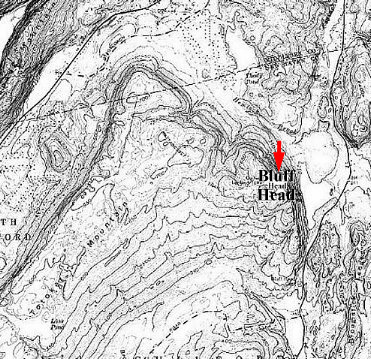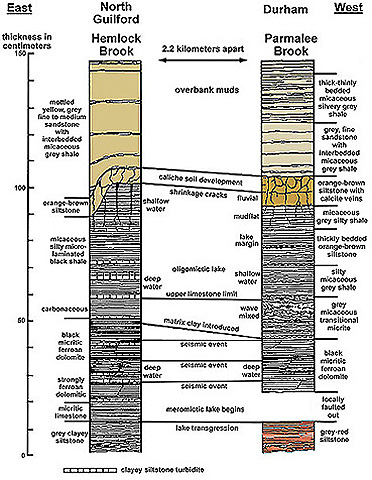Massive Ancient Fish Kills
Nature's Pollution
200 million years ago fish called Redfieldius, Ptycholepis, and Semionotus died by the tens of thousands during severe storms, sinking to the bottom of an ancient lake where their fossils were preserved in many layers of black shale. That shale formed from organic-rich muds deposited at the bottom of this ancient freshwater lake.
How could storms kill so many fish so many different times?
Table
of Contents |
| Webpage 1:
History, methodology, location, stratigraphy, and fish genera. Webpage 2: Detailed lake-bed stratigraphy and chemical analysis. Webpage 3: Graphic distribution of fish genera, coprolites, and leaf fossils through the lake bed, along with the chemical analysis of a coprolite. The reason for so many fish kill layers is given on this page. Webpage 4: Graph showing geologic history, examples of reef limestone, and diagrams of selected fish kill layers. |
A fossil fish locality in the Shuttle Meadow Formation is mentioned by Davis and Loper in their 1891 publication entitled, Two belts of fossiliferous black shale in the Triassic formation of Connecticut. That locality was rediscovered by Nicholas G. McDonald and Bruce Cornet in 1969 after an extensive search of the slopes and streams on Totoket Mountain, east of New Haven, CT. A large excavation followed, which involved the removal of tons of rock overburden using pickaxe and shovel, the careful dissection of a six foot by three foot section of black shale, layer by layer, and the transportation of thousands of pounds of specimens in backpacks down the side of that mountain over the course of two field seasons. A detailed record of what they found is the subject of this report.
So many fossil fish were found that the uniqueness of this deposit begged for protection from commercial and amateur fossil collectors. Because of the lobbying effort of N.G. McDonald, the State of Connecticut bought the land and turned it into a State Park. Another park in the Hartford basin was created after construction uncovered numerous layers of red mudrock (East Berlin Formation) containing thousands of dinosaur trackways. Visitors can now see many of those trackways at the Rocky Hill Dinosaur State Park, CT, where they are exposed and protected by enclosures. Those dinosaurs lived at about the same time the fish swam in the Bluff Head lake. The uniqueness of the fish deposit also begged for answers to the following questions:
Why did so many fish die, and what was the cause?
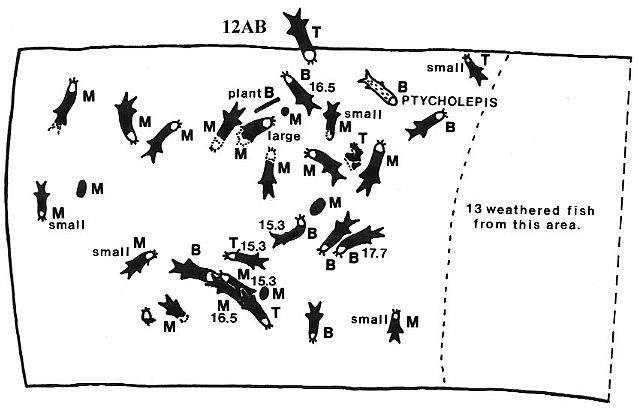
Six foot wide excavation from the middle of the lake bed sequence showing three superimposed fish kills (T = top; M = middle; B = bottom; numbers represent lengths of fishes in centimeters).
"Interesting, but so what!" you say. Why should something that happened in the past, let alone 200 million years ago, have any bearing on what is happening today? Why should I care? I've got a family to feed. Don't bother me with distractions. And if I should care, what bearing does this study have on today's environmental problems?
The Scientific Method
Scientists are generally viewed as objective seekers of the truth. Their opinion is usually considered valid by the News Media, but often it is considered too conservative and cautious by the public. Because of that conservatism and caution, scientific opinion might even appear to be naive, deficient, and/or misleading. How does a scientist collect and analyze data, and why should his/her opinion be valued more than public opinion? What differences are important in distinguishing between scientific opinion and public opinion?
Scientists are trained to collect and analyze as much data as possible in order to form a reasonable basis for an interpretation. The data must be collected in an organized and well-planned manner, and must be recorded so that other scientists can judge the methodological precision of the collector. The analysis phase should include whatever methods are available to extract as much useful information as possible in order to eliminate competing interpretations which are supported by smaller data sets. The interpretation phase needs to explore all probable interpretations regardless of their implications, and should look for the most parsimonious explanation, which uses the fewest levels of inference and assumption. In other words, the most likely interpretation is the one which is the least complex or least dependent on special conditions after all relevant data are considered. Public opinion, however, is quite frequently formed from inadequate data or is based on untested hypotheses and false assumptions.
In order to determine why so many thousands of fish died at such regular intervals through the layers of the fish deposit, the following tasks had to be completed:
- Excavate
and remove several tons of rock strata on top of the fish deposit.
- Maintain
a path for the stream so that rock tailings did not divert the stream and cause local
environmental disturbances.
- Remove
the layers of lake bed one at a time and carefully dissect each layer in order to locate
as many fossils as possible.
- Collect
a complete stratigraphic section from at least two dissimilar locations within the
excavation, and return them to the laboratory for cutting and analysis.
- Note
every geologic and stratigraphic feature or anomaly, and record how they are distributed
within the excavation layers.
- Record
the position, orientation, and if possible size of each and every fossil found on a master
map or plan of the excavation (only some specimens could be exposed in their entirety at
the location).
- Prepare
as many complete specimens of fish as possible in order to effectively identify them.
- Prepare
for study the head bones of representative fish types for taxonomic analysis and the
determination of species diversity.
- Analyze
the various layers of strata from a sedimentological, mineralogical, and chemical
standpoint. Chemical analysis was done in a wet chem laboratory using standard analytical
techniques.
- Tally
and compile all data so that correlations and relationships could be understood. This was
done using charts and graphs.
- Develop
a theory to explain the fish kills and changing composition of the fish population
contained in the fish kill layers.
- Return
to the excavation site and make a second excavation next to the first one in order to test
various ideas generated by the theory.
- Visit
other localities which expose the same lake bed in order to document any facies
changes and the environmental history of the lake.
- Write
up the results, submit the results for peer review, and publish the edited results.
Peer review is essential for catching mistakes.
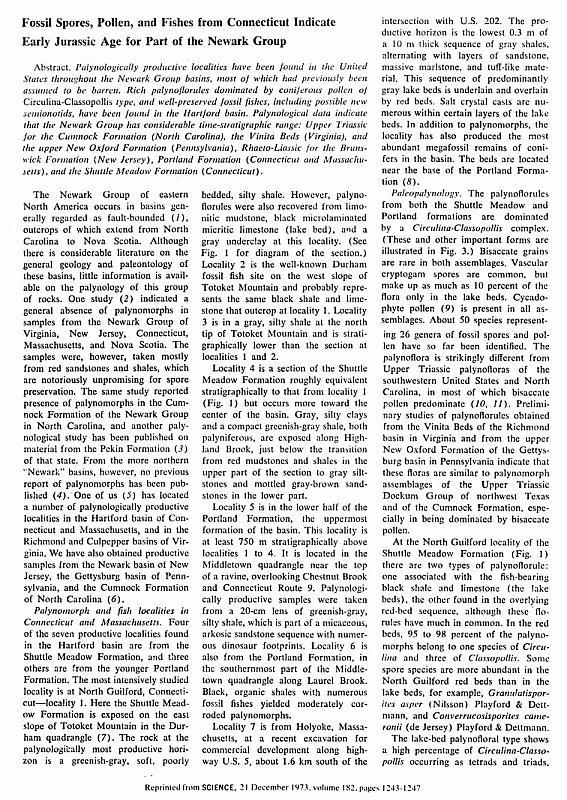
Cornet, B., Traverse, A., and McDonald, N.G., 1973. Fossil spores, pollen, and fishes from Connecticut indicate Early Jurassic age for part of the Newark Group. Science, December, vol. 182, p. 1243-1247.
Because of limitations placed by the editors of Science on the amount of data authors can include, only a small part of what was discovered was presented in the first publication. Later, McDonald coauthored two papers with leading paleoichthyologists at the New York American Museum of Natural History.
Schaeffer, B., Dunkle, D.H., and McDonald, N.G., 1975. Ptycholepis marshi Newberry, a chondrostean fish from the Newark Group of Eastern North America. Fieldiana Geology, vol. 33, no. 12, p. 205-233.
Schaeffer, B. and McDonald, N.G., 1978. Redfieldiid fishes from the Triassic-Liassic Newark Supergroup of Eastern North America. American Museum of Natural History, vol. 159, article 4, p. 131-173.
Additional data on the Semionotids from this lake deposit were published in two papers by other authors.
Olsen, P.E., McCune, A.R., and Thomson, K.S., 1982. Correlation of the Early Mesozoic Newark Supergroup by vertebrates, principally fishes. American Journal of Science, vol. 282, p. 1-44.
Olsen, P.E., and McCune, A.R., 1991. Morphology of the Semionotus elegans species group from the Early Jurassic part of the Newark Supergroup of Eastern North America with comments on the family Semionotidae (Neopterygii). Journal of Vertebrate Paleontology, vol. 11, no. 3, p. 269-292.
The four papers on fossil fish taxonomy did not contain any significant information on the distribution of fishes in the fossil lake deposit, nor did they contain information on the changing ecology of that ancient lake based on sedimentological and taphonomic changes in the shale layers. This report contains that information.
The
Bluff Head locality on east side of Totoket Mountain, North Guilford, Connecticut.
Stratigraphy |
||
Formation or Rock Unit U. Portland Formation L. Portland Formation Hampden basalt East Berlin Formation Holyoke basalt Shuttle Meadow Formation Talcott basalt New Haven Arkose |
~Thickness 1000+ meters 1000 meters 60 meters 150 meters 100 meters 100 meters 65 meters 2250 meters |
Age Pleinsbachian Hettangian-Sinemurian Hettangian Hettangian Hettangian Hettangian Hettangian Late Carnian-Hettangian |
What the second excavation looked like.
Talus has slumped over the first excavation to the right.
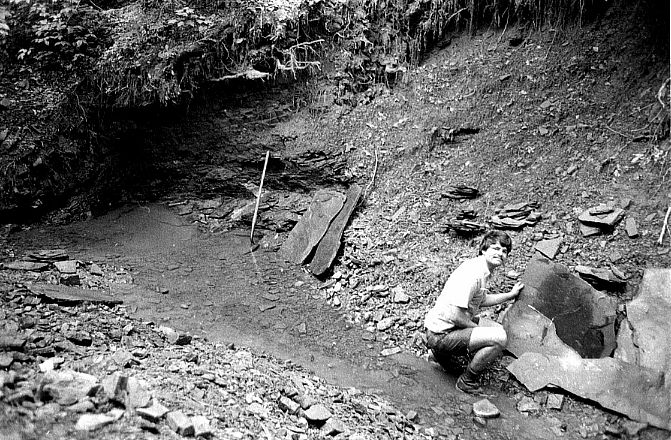
The Bluff Head excavation site (above) showing a large man-made hole in the side of the outcrop: Nick McDonald inspecting several slabs of black shale containing at least six fossil fish on their surfaces (Summer 1970).
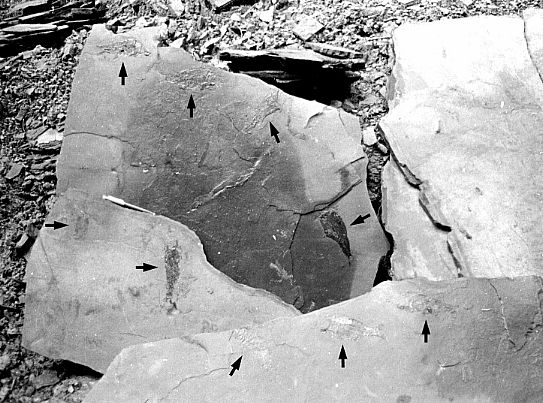
Close-up of the black shale slabs (above) with arrows pointing to fossil fishes; note that adjoining sides of shale layers will contain portions and/or impressions of the same fossil (called "part" and "counterpart").
Description of Data
Cast of Characters by Genus
Redfieldius
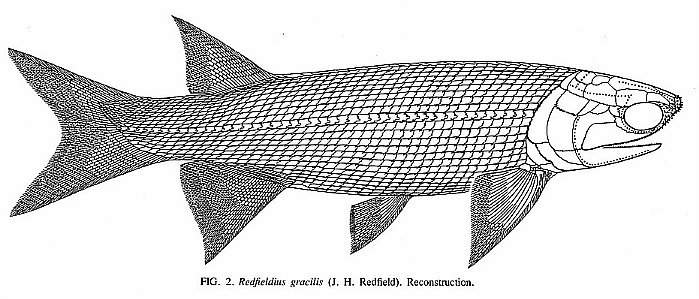
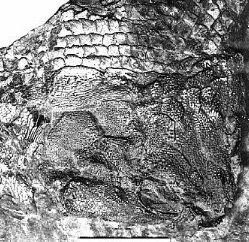
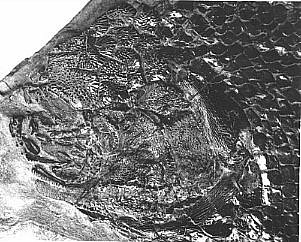
Drawing from Schaeffer and McDonald, 1978.
Ptycholepis
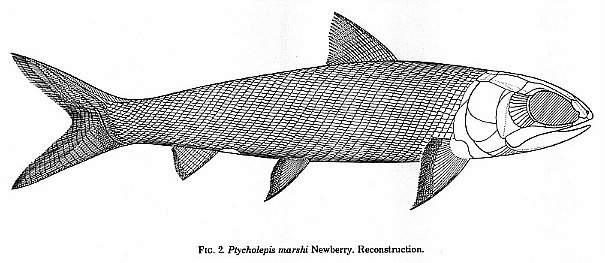
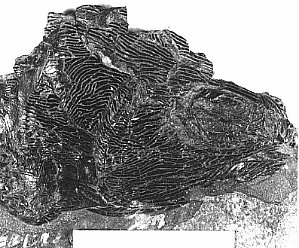
Drawing from Schaeffer, Dunkle, and McDonald, 1975.
Semionotus
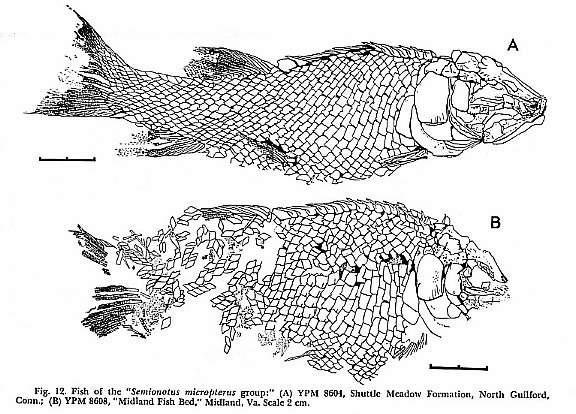
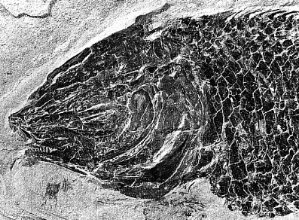
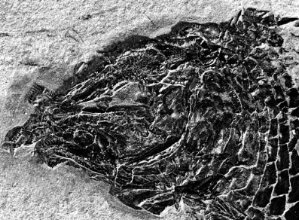
Drawing from Olsen, McCune, and Thomson, 1982.
Diplurus
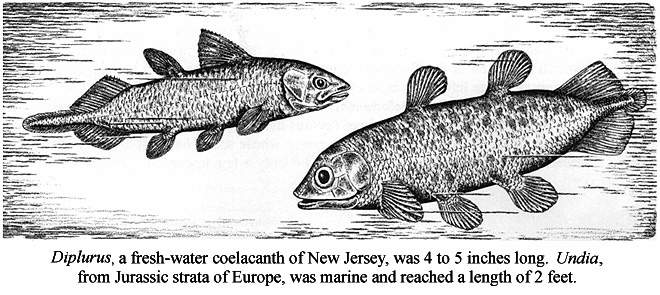
Drawing from Fenton and Fenton, 1958 (The fossil book).
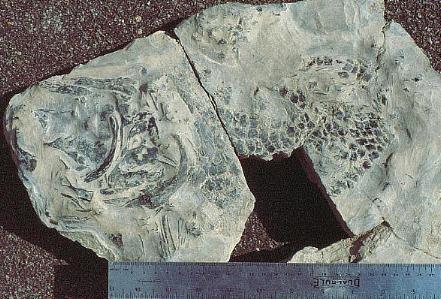
Specimen from the Lower Jurassic, Catlett's Branch, Culpeper basin, VA.eferences
Cornet, B., Traverse, A., and McDonald, N.G., 1973. Fossil spores, pollen, and fishes from Connecticut indicate Early Jurassic age for part of the Newark Group. Science, December, vol. 182, p. 1243-1247.
Davis, W.M. and Loper, S.W., 1891. Two belts of fossiliferous black shale in the Triassic Formation of Connecticut. Geol. Soc. America Bull., vol. 2, p. 415-430.
Fenton, C.L. and Fenton, M.A., 1958. The fossil book, the exciting story of plants, animals, and lesser creatures during the past two billion years. Doubleday & Company, Inc., Garden City, New York, 481 pages.
Olsen, P.E. and Gore, P.J.W. (eds.), 1989. Tectonic, depositional, and paleoecological history of Early Mesozoic rift basins, Eastern North America, Gulf, North Carolina, USA to Parrsboro, Nova Scotia, Canada, Field Trip Guidebook T351. American Geophysical Union, Washington, D.C., 173 pages.
Olsen, P.E., McCune, A.R., and Thomson, K.S., 1982. Correlation of the Early Mesozoic Newark Supergroup by vertebrates, principally fishes. American Journal of Science, vol. 282, p. 1-44.
Olsen, P.E., and McCune, A.R., 1991. Morphology of the Semionotus elegans species group from the Early Jurassic part of the Newark Supergroup of Eastern North America with comments on the family Semionotidae (Neopterygii). Journal of Vertebrate Paleontology, vol. 11, no. 3, p. 269-292.
Schaeffer, B., Dunkle, D.H., and McDonald, N.G., 1975. Ptycholepis marshi Newberry, a chondrostean fish from the Newark Group of Eastern North America. Fieldiana Geology, vol. 33, no. 12, p. 205-233.
Schaeffer, B. and McDonald, N.G., 1978. Redfieldiid fishes from the Triassic-Liassic Newark Supergroup of Eastern North America. American Museum of Natural History, vol. 159, article 4, p. 131-173.
Copyright B. Cornet 1999.
This web page last modified on 08/19/2013.

